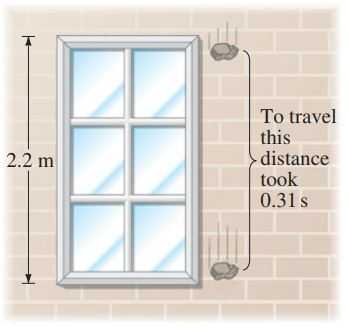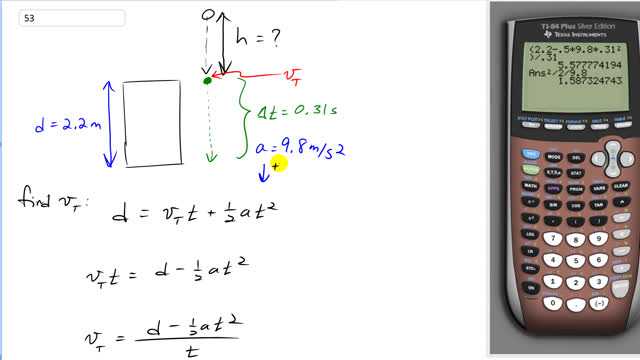
A falling stone takes 0.31 s to travel past a window 2.2 m tall (Fig. 2-41). From what height above the top of the window did the stone fall?


In order to watch this solution you need to have a subscription.
This is Giancoli Answers with Mr. Dychko. So the following stone takes 0.31 seconds to pass this distance 2.2 meters downwards past this window and we are gonna take downward to be the positive direction just to make our algebra a little simpler, we don't have to worry about negative signs so much so that gives acceleration is positive 9.8 meters per second squared downwards displacement will also be 2.2 meters positive downwards. and we are gonna first find out, what is the speed at the top of the window? and then once we know the speed, we can find the height because we know the speed up here, where it was originally dropped is zero so v initial way up here is zero for sure and the whole question is what is this height above the window that it was initially dropped from. So first we'll find this speed v top v T top of the window using this formula and then use this formula to find the height h and we are good to go. So we'll solve this for v T and we'll subtract one-half at squared from both sides and then we have v T times t equals d minus one-half at squared then divide both sides by t and then we have a formula solving for v T top of the window in terms of stuff that we know. And that's 2.2 meters minus one-half 9.8 meters per second squared times 0.31 seconds and square that time and then divide everything by the time 0.31 that gives 5.5778 meters per second is the speed the stone must have passed the top of the window. And then that's the final speed when you consider this portion there that portion of time or that height above the window the final speed of this part of the fall is the speed at the top of the window and so when we use this formula, we have v final squared equals the initial squared plus 2 times a times displacement. Now the initial speed is zero and we can solve for the the height above the window by dividing both sides by 2a then and this term is gone which is nice and we have the height then is v at the top—5.5778 meters per second— and we square that speed divide it by 2 and then also divide by 9.8 gives oops, I wrote the wrong number there that gives a height of 1.6 meters above the window.